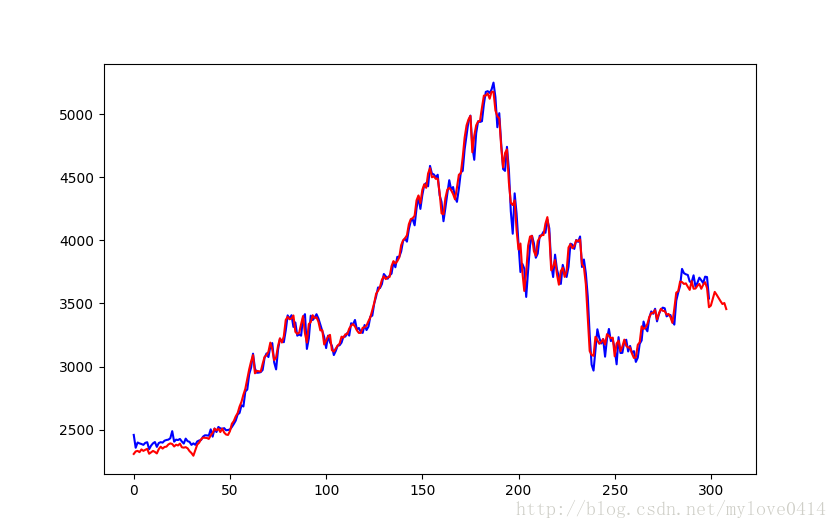根据股票历史数据中的最低价、最高价、开盘价、收盘价、交易量、交易额、跌涨幅等因素,对下一日股票最高价进行预测。
实验用到的数据长这个样子:

label是标签y,也就是下一日的最高价。列C——I为输入特征。 本实例用前5800个数据做训练数据。
单因素输入特征及RNN、LSTM的介绍请戳上一篇 Tensorflow实例:利用LSTM预测股票每日最高价(一)
导入包及声明常量
import pandas as pd
import numpy as np
import tensorflow as tf
#定义常量
rnn_unit=10 #hidden layer units
input_size=7
output_size=1
lr=0.0006 #学习率导入数据
f=open('dataset.csv')
df=pd.read_csv(f) #读入股票数据
data=df.iloc[:,2:10].values #取第3-10列生成训练集、测试集
考虑到真实的训练环境,这里把每批次训练样本数(batch_size)、时间步(time_step)、训练集的数量(train_begin,train_end)设定为参数,使得训练更加机动。
#——————————获取训练集——————————
def get_train_data(batch_size=60,time_step=20,train_begin=0,train_end=5800):
batch_index=[]
data_train=data[train_begin:train_end]
normalized_train_data=(data_train-np.mean(data_train,axis=0))/np.std(data_train,axis=0) #标准化
train_x,train_y=[],[] #训练集x和y初定义
for i in range(len(normalized_train_data)-time_step):
if i % batch_size==0:
batch_index.append(i)
x=normalized_train_data[i:i+time_step,:7]
y=normalized_train_data[i:i+time_step,7,np.newaxis]
train_x.append(x.tolist())
train_y.append(y.tolist())
batch_index.append((len(normalized_train_data)-time_step))
return batch_index,train_x,train_y
#——————————获取测试集——————————
def get_test_data(time_step=20,test_begin=5800):
data_test=data[test_begin:]
mean=np.mean(data_test,axis=0)
std=np.std(data_test,axis=0)
normalized_test_data=(data_test-mean)/std #标准化
size=(len(normalized_test_data)+time_step-1)//time_step #有size个sample
test_x,test_y=[],[]
for i in range(size-1):
x=normalized_test_data[i*time_step:(i+1)*time_step,:7]
y=normalized_test_data[i*time_step:(i+1)*time_step,7]
test_x.append(x.tolist())
test_y.extend(y)
test_x.append((normalized_test_data[(i+1)*time_step:,:7]).tolist())
test_y.extend((normalized_test_data[(i+1)*time_step:,7]).tolist())
return mean,std,test_x,test_y构建神经网络
#——————————————————定义神经网络变量——————————————————
def lstm(X):
batch_size=tf.shape(X)[0]
time_step=tf.shape(X)[1]
w_in=weights['in']
b_in=biases['in']
input=tf.reshape(X,[-1,input_size]) #需要将tensor转成2维进行计算,计算后的结果作为隐藏层的输入
input_rnn=tf.matmul(input,w_in)+b_in
input_rnn=tf.reshape(input_rnn,[-1,time_step,rnn_unit]) #将tensor转成3维,作为lstm cell的输入
cell=tf.nn.rnn_cell.BasicLSTMCell(rnn_unit)
init_state=cell.zero_state(batch_size,dtype=tf.float32)
output_rnn,final_states=tf.nn.dynamic_rnn(cell, input_rnn,initial_state=init_state, dtype=tf.float32) #output_rnn是记录lstm每个输出节点的结果,final_states是最后一个cell的结果
output=tf.reshape(output_rnn,[-1,rnn_unit]) #作为输出层的输入
w_out=weights['out']
b_out=biases['out']
pred=tf.matmul(output,w_out)+b_out
return pred,final_states
训练模型
#——————————————————训练模型——————————————————
def train_lstm(batch_size=80,time_step=15,train_begin=0,train_end=5800):
X=tf.placeholder(tf.float32, shape=[None,time_step,input_size])
Y=tf.placeholder(tf.float32, shape=[None,time_step,output_size])
batch_index,train_x,train_y=get_train_data(batch_size,time_step,train_begin,train_end)
pred,_=lstm(X)
#损失函数
loss=tf.reduce_mean(tf.square(tf.reshape(pred,[-1])-tf.reshape(Y, [-1])))
train_op=tf.train.AdamOptimizer(lr).minimize(loss)
saver=tf.train.Saver(tf.global_variables(),max_to_keep=15)
module_file = tf.train.latest_checkpoint()
with tf.Session() as sess:
#sess.run(tf.global_variables_initializer())
saver.restore(sess, module_file)
#重复训练2000次
for i in range(2000):
for step in range(len(batch_index)-1):
_,loss_=sess.run([train_op,loss],feed_dict={X:train_x[batch_index[step]:batch_index[step+1]],Y:train_y[batch_index[step]:batch_index[step+1]]})
print(i,loss_)
if i % 200==0:
print("保存模型:",saver.save(sess,'stock2.model',global_step=i))嗯,这里说明一下,这里的参数是基于已有模型恢复的参数,意思就是说之前训练过模型,保存过神经网络的参数,现在再取出来作为初始化参数接着训练。如果是第一次训练,就用sess.run(tf.global_variables_initializer()),也就不要用到 module_file = tf.train.latest_checkpoint() 和saver.store(sess, module_file)了。
测试
#————————————————预测模型————————————————————
def prediction(time_step=20):
X=tf.placeholder(tf.float32, shape=[None,time_step,input_size])
mean,std,test_x,test_y=get_test_data(time_step)
pred,_=lstm(X)
saver=tf.train.Saver(tf.global_variables())
with tf.Session() as sess:
#参数恢复
module_file = tf.train.latest_checkpoint()
saver.restore(sess, module_file)
test_predict=[]
for step in range(len(test_x)-1):
prob=sess.run(pred,feed_dict={X:[test_x[step]]})
predict=prob.reshape((-1))
test_predict.extend(predict)
test_y=np.array(test_y)*std[7]+mean[7]
test_predict=np.array(test_predict)*std[7]+mean[7]
acc=np.average(np.abs(test_predict-test_y[:len(test_predict)])/test_y[:len(test_predict)]) #acc为测试集偏差最后的结果画出来是这个样子:

红色折线是真实值,蓝色折线是预测值
偏差大概在1.36%
代码和数据上传到了github上,想要的戳全部代码
注!:如要转载,请经过本人允许并注明出处!